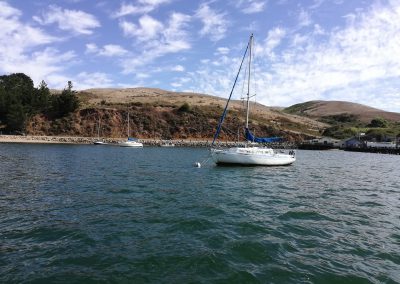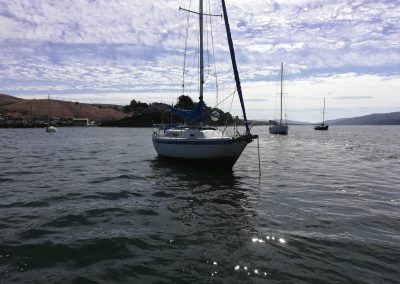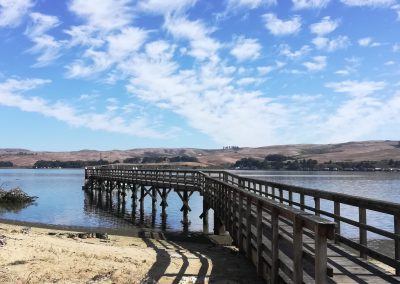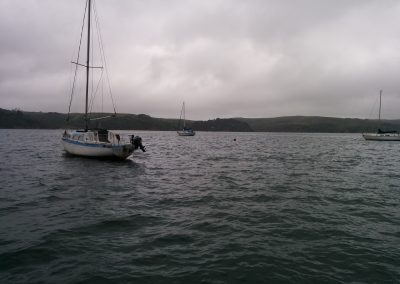
Contact
For inquiries or questions regarding Tomales Bay, please contact the Tomales Bay team at TomalesBay.Public@slc.ca.gov.
The Commission, in partnership with the Greater Farallones National Marine Sanctuary, is administering the Tomales Bay Mooring Program. This page provides essential information for existing private mooring owners on Tomales Bay and those who are interested in installing a new mooring. The information here is provided for mooring lease applicants to ensure that moorings on Tomales Bay are in compliance with state and federal regulations.
The Commission is now accepting mooring lease applications from any party interested in applying for a mooring lease within the sovereign lands of Tomales Bay. All mooring lease applicants are required to submit a Commission mooring lease application and provide all required additional information as outlined in the Tomales Bay Mooring Program Requirements.
Mooring Program Frequently Asked Questions
- Where are moorings allowed within Tomales Bay? Can I moor outside the zones?
- What are the requirements for mooring in the bay?
- When can I apply for a Tomales Bay Mooring Lease?
- How will my application be processed?
- What are the requirements for mooring installation?
- Where can I access the Interactive PDF map?
- What constitutes Mooring versus Anchoring?
- Where can I find current regulations on anchoring in Tomales Bay?
Where are moorings allowed within Tomales Bay? Can I moor outside the zones?
Moorings and associated ground tackle shall be located within the boundaries of the Mooring Program Mooring Zones (depicted in the Interactive PDF Map and in the Tomales Bay Mooring Program Requirements document). Littoral (waterfront) property owners can apply for a mooring that is located adjacent to a corresponding developed littoral property. Littoral property owner moorings must be placed outside the combined mooring exclusion zone depicted in the Interactive PDF Map, which shows the areas excluded by the mooring criteria. Additional information on mooring placement, in general, can be found in the Tomales Bay Mooring Program Requirements.
What are the requirements for mooring in the bay?
The mooring lease applicant is responsible for reading and complying with the Tomales Bay Mooring Program Requirements, which includes all program criteria and policies. A mooring lessee is responsible for:
- Ensuring that the mooring equipment is inspected annually and maintained by an approved Mooring Contractor. The lessee must check the Approved Mooring Contractors prior to scheduling an installation or inspection
- Informing the Commission of any changes (moored vessel, mailing address, telephone number, etc.)
- Submitting proof of vessel and mooring insurance annually, and
- Staying current on payment of annual rent
When can I apply for a Tomales Bay Mooring Lease?
The Commission is now accepting mooring lease applications from any party interested in applying for a mooring lease within the sovereign lands of Tomales Bay.
How will my application be processed?
All complete applications will be processed sequentially based on the order received. If an application is considered by the Commission to be incomplete, additional information will be requested until such time the application package is complete. If the proposed mooring location or mooring tackle is determined by the Commission to be inconsistent with mooring siting criteria or other requirements of the Mooring Program, Commission staff will work with the Applicant to revise their application. Mooring leases will be issued until the maximum allowable number of authorized moorings on Tomales Bay (165) has been reached. It should be noted that each approved siting area has a maximum mooring capacity. It may be necessary for the applicant to select an alternate location if the maximum capacity has already been met in the preferred location. Maximum mooring capacity will be set by consultation with approved Mooring Contractors, GFNMS, and the Commission. Maximum mooring capacity will be dependent on the size of vessels to be moored in each location. For more information on the mooring lease application process refer to the Tomales Bay Mooring Program Requirements document.
What are the requirements for mooring installation?
All mooring lease applicants shall submit a Tomales Bay Mooring Program Pre-Installation Mooring Proposal with their application to the Commission. If the application is approved, then mooring must be installed by an approved Mooring Contractor in the approved location within 180 days of Commission issuance of the lease.
See the following website for a list of Approved Mooring Contractors: http://farallones.noaa.gov/eco/tomales/contractors.html
Where can I access the Interactive PDF map?
For more information on the Tomales Bay Mooring Program Interactive PDF Map and to download the map visit this site: http://farallones.noaa.gov/eco/tomales/map.html.
What constitutes Mooring versus Anchoring?
An anchor is attached to a vessel by a cable and dropped overboard to grip the bottom and generally restrict the vessel’s movement. The anchor is pulled onto the vessel and not left in the water when the vessel is underway. A mooring is a structure that includes an anchor and chain, but is placed in the water with a float to demarcate the anchor and chain. A mooring is left in place in the water with a buoy demarcating its location when the vessel is underway.
Where can I find current regulations on anchoring in Tomales Bay?
Anchoring is allowed in Tomales Bay except anchoring a vessel in a designated seagrass protection zone, except as necessary for aquaculture operations conducted pursuant to a valid lease, permit, or license. The seagrass protection zones are depicted in the links below. The coordinates of all seven zones can be found in 15 CFR Part 922, Subpart H Appendix B. It is important to be aware of where you are anchoring in Tomales Bay and avoid anchoring in seagrass (eelgrass) at all times.





